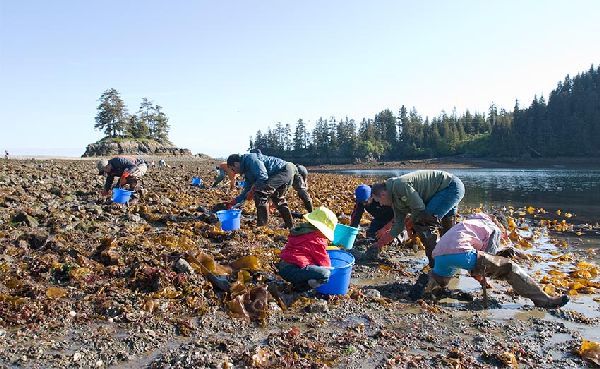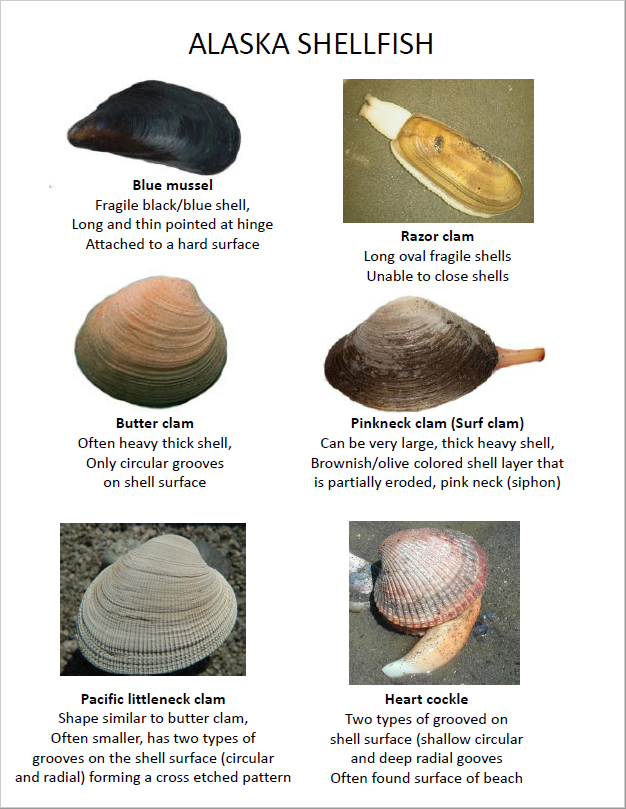Shellfish Recreational Harvesting
Know Before You Dig - Paralytic Shellfish Toxin


Subsistance harvesting at Jakolof Bay. Photo courtesy of Dave Partee/Alaska Sea Grant
There are no beaches that are certified or designated as "safe" beaches for shellfish harvesting in Alaska. All recreationally-harvested shellfish — including clams, mussels, oysters, geoducks, and scallops — may contain paralytic shellfish toxin (PST) that, if ingested, can cause death.
If you choose to harvest shellfish in Alaska, it is important that you know the facts about PST, know the species you plan to harvest, and know the symptoms of paralytic shellfish poisoning and get help quickly!
Get medical help immediately if you experience nausea, vomiting, diarrhea, abdominal pain, and tingling or burning lips, gums, tongue, face, neck, arms, legs, and toes, shortness of breath, dry mouth, a choking feeling, confused or slurred speech, and lack of coordination.
Summertime Precaution - Vibrio
Due to rising temperatures in the summer, bacteria levels also rise. Of particular concern are species of Vibrio which can cause severe illness if ingested. The precautions listed in this section should be followed if you're planning on a summer harvesting trip.
- Harvest Soon After Tide - It is best to harvest as soon as you can after tide goes out. Harvest at the beginning of the tide cycle instead of at the end.
- Avoid Shellfish Sitting in Sun - Shellfish should not be harvested if they have been exposed to direct sunlight for more than 2 hours.
- Immediately Cool - Shellfish should be immediately placed on ice or refrigerated after they are harvested
- Thoroughly Cook - Sufficiently cooking shellfish can destroy Vibrio that is present in the shellfish.This can prevent food poisoning. See section below for instructions on how to properly cook shellfish. Note: Cooking does not destroy shellfish toxins like Paralytic Shellfish Toxin and Domoic Acid, so cooking does not guarantee your harvest will be safe to eat.
Storing Shellfish
- Keep Shellfish Cool - Allowing the temperature to rise will cause bacteria to grow and make the shellfish unsafe to eat.
- Fresh Shellfish - All fresh shellfish should be stored in an open container in the refrigerator with a damp towel placed on top of them to maintain humidity. Never store shellfish in water as they will die and spoil. If the shellfish is open and doesn't close when tapped, it is dead and should be thrown out. Storage times for fresh shellfish can vary:
- Shellfish That Close Their Shells Completely - Most species can be stored for up to seven days except mussels which can be stored for 3-4 days.
- Shellfish That Cannot Completely Close Their Shells - Can be stored for 3-4 days.
- Shucked Shellfish - Shellfish removed from their shell can be kept refrigerated for up to 3 days or frozen for up to 3 months.
- Cooked Shellfish - Cooked shellfish can be kept refrigerated for up to 2 days and frozen for up to 3 months.
- Thawed Shellfish - Shellfish that have been kept frozen and thawed in a refrigerator can be kept for up to 2 days. Once Thawed, do not refreeze.
Cooking Shellfish
To ensure proper food safety, shellfish must be cooked to an internal temperature of at least 145°F. It is often impractical to measure this with a food thermometer, so below are a few recommended techniques for fully cooking shellfish.
- Shucked Shellfish - Shucked shellfish become plump and opaque when cooked thoroughly, and if the shellfish is an oyster, its edges will begin to curl.
- Clams, Mussels, & Oysters (In Shell) - Shellfish in the shell will open after it is cooked, and they should continue to be cooked for a few minutes after opening. Throw away shellfish that do not open after cooking.
- Scallops - Scallops will turn milky white or opaque and firm. Depending on size, scallops often take 3-4 minutes to cook thoroughly.
Resources
- Paralytic Shellfish Poisoning (PSP)
- PSP is a serious illness caused by eating shellfish contaminated with algae that contains Paralytic Shellfish Toxin (PST), a toxin harmful to humans.
- ADF&G Subsistence and Personal Use – Licenses and Permits
- Information on subsistence and personal use harvest of shellfish in Alaska through the Department of Fish and Game.
- How to Eat Clams and Protect Yourself from PSP Too
- Environment Alaska offers information on staying safe while harvesting shellfish.
- Alaska Shellfish Identification
- A one-page chart with color photographs to help identify common shellfish in Alaskan waters.
-


 Indicates an external site.
Indicates an external site.